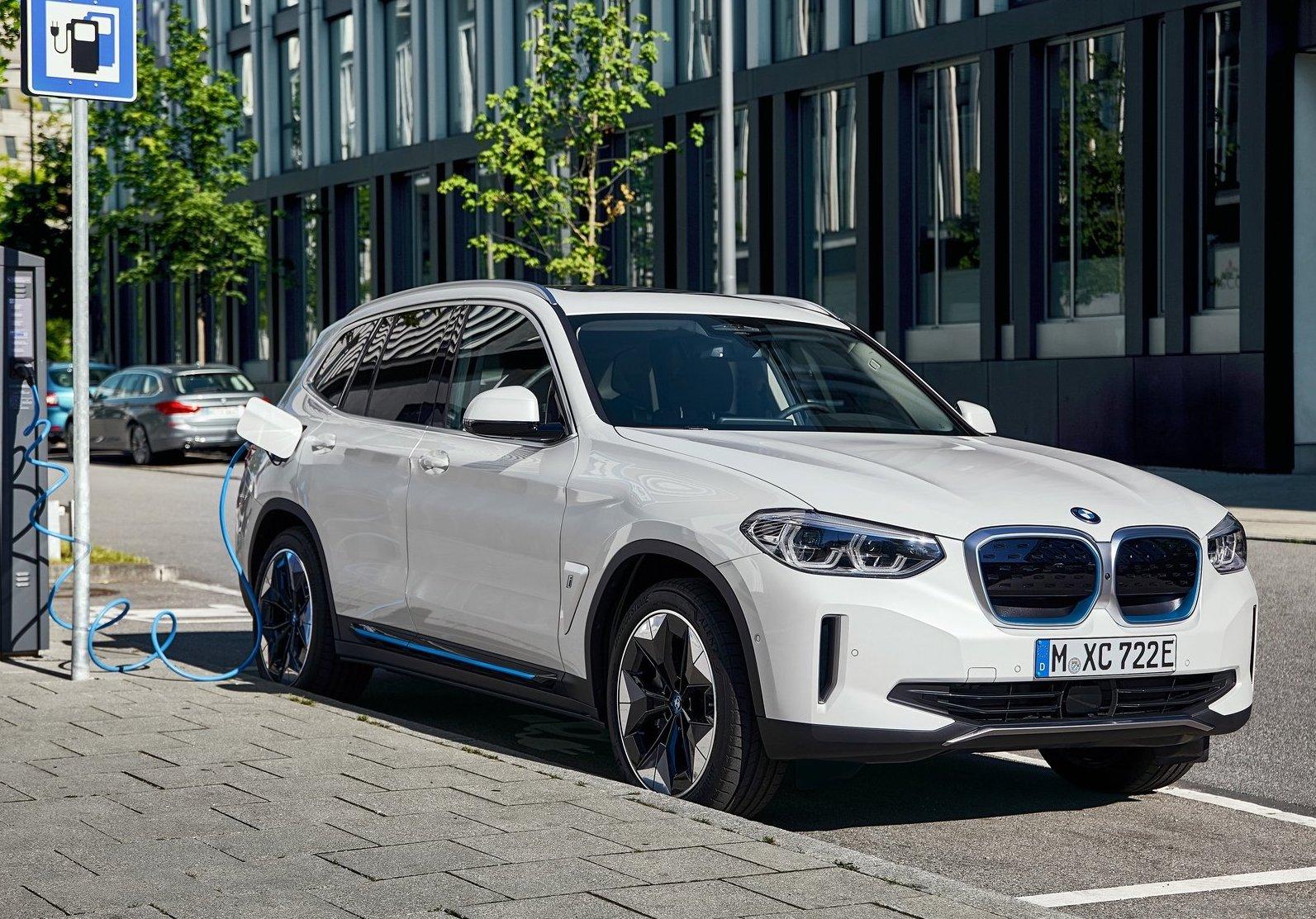Like it or not the future of electric vehicles running around our cities looks to be inevitable, as much as the dying breed of petrol-heads like us might deny it. And to rub salt on the wounds, it is the booming SUV market that is receiving all the EV love and attention. Why the SUV segment? Well, the world wants more SUV’s and the sales of SUV’s of all sizes and types is overtaking the demand for sedans in nearly all mature car markets around the world.
Following on from the radical looking Tesla Model X, the Audi e-Tron and the sleek looking Jaguar I-Pace, the next SUV in line to get the EV treatment is this all new BMW iX3 which looks very much like its petrol and diesel sibling, the regular X3.

This pure electric iX3 is, in simple terms, an electric version of BMW’s popular mid-sized crossover, the X3. The latest addition to BMW’s i range of electric vehicles, the iX3 is most conventional looking model of that growing range, a departure from the futuristic electric i3 and hybrid i8.
Utilising the German marque’s fifth generation eDrive technology, the iX3 has a range off up to 460 km thanks to an 80 kWh battery pack. If you want to feel the EV acceleration sensation, best to look elsewhere, as although the iX3 puts out 286 hp and 400 Nm of torque, the 0 to 100 km/h sprint in a reasonable 6.8 seconds. Fast for an SUV, but not exactly fast for an EV.
Other than the electric powertrain, the iX3 is nearly identical to the conventional X3, save for a few EV tech like the BMW Charging Card that enables the use of 450,000 charge points worldwide and BMW IconicSounds Electric feature that supposedly “adds extra emotional depth to the driving experience” by piping in sounds through the car’s sound system.
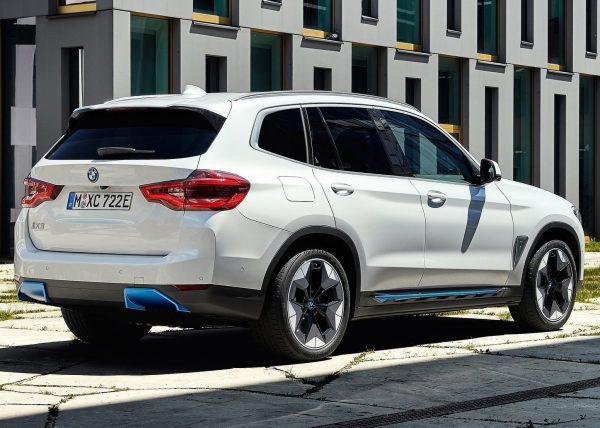
Built in BMW’s new Shenyang plant in China, this new 5 seat crossover may be the next crossover to the environmentally conscious driver who still wants Ultimate Driving Pleasure… from an SUV.
More information can be found in the Press Release below:
Press Release: BMW X3 model range with flexible drive system technology and wide-reaching charging strategy answers mobility needs worldwide
The new BMW iX3 is a fully-fledged Sports Activity Vehicle whose myriad qualities are rooted in the conceptual blueprint of the globally successful, conventionally powered BMW X3. The SAV for the premium midsize segment is one of the BMW brand’s first models whose architecture offers a new level of flexibility within the drive system technology developed for it. Thanks to this future-focused approach, the BMW X3 will be the brand’s first model to be available with highly efficient petrol and diesel engines, a locally emission-free plug-in hybrid system or a pure-electric drive.
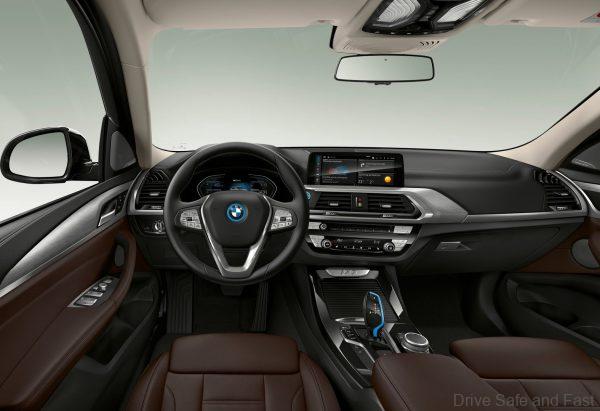
The flexibility built into the BMW X3 embodies the strategic Power of Choice approach the BMW Group has implemented to meet the specific mobility needs of customers around the world. To this end, a wide spectrum of drive system technologies has spawned a selection of precisely targeted models adapted to meet a vast array of legal parameters and individual requirements.
The BMW iX3 has a unique rear axle subframe and bespoke chassis integration to help it meet the particular demands on a pure-electric vehicle concept. As well as the instantaneous power delivery of its electric motor and model-specific suspension tuning, it offers the combination of sporty, agile handling, excellent direction stability and supreme traction in adverse weather conditions and on loose ground, fulfilling customers expectations of a Sports Activity Vehicle.
With these qualities in place, the new BMW iX3 has an eye on both the current requirements of the electric vehicle segment and its future face. In its fifth generation, the BMW eDrive technology has reached a level of development beyond the one of market rivals and it provides an outstanding basis for economically sustainable applications in volume production models. At the same time, the strong appeal of its vehicle concept goes hand in hand with the rising demand worldwide for all-electric premium cars. The arrival of a highly efficient electric model in the globally popular premium midsize Sports Activity Vehicle segment contributes hugely to the reduction in CO2 emissions from road traffic. The new BMW iX3 is therefore the right electric vehicle at the right time.
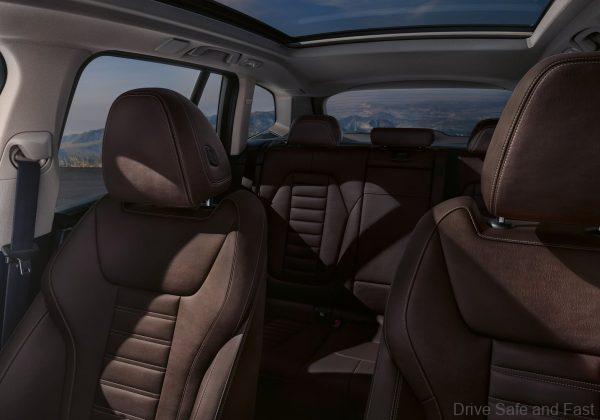
BMW iX3 Sports Activity Vehicle blazes a trail for sustainable mobility
And so a BMW X model once again acts as a pioneer for a new and ground-breaking take on the brand’s hallmark driving pleasure. In 2015 the predecessor of the current BMW X5 xDrive45e became the first plug-in hybrid to be offered by the core BMW brand, joining the BMW i8 as the second PHEV in the BMW Group range. Following in the tyre tracks of the BMW i3 and MINI Cooper SE, the BMW iX3 is now the first pure-electric X model in the BMW Group portfolio. By 2023 the plan is for the number of electrified models in the line-up to have reached 25, of which 13 will run on electric power alone.
The development of the BMW iX3 was based on the experience amassed by the BMW i brand since 2011 and the BMW Group’s well-grounded expertise in the field of electric mobility. The history of electric mobility at BMW can be traced back to 1972, when electrically powered variants of the BMW 02 saw action as support vehicles for marathon races at the Olympic Games in Munich. The years that followed yielded a number of prototypes with electric drive systems, which helped the engineers to build up a substantial knowledge base on e-mobility and the technology required to make it work. The launch of Project i in 2007 lit the fuse for the development of a series-produced model conceived from the ground up to provide electric mobility in urban areas. The BMW i3 went on sale in 2013, followed by the BMW i8 – still the world’s most successful plug-in hybrid sports car – in 2014.
Since then, the BMW i brand has acted as a breeding ground for the electrified drive systems now found in BMW and MINI brand models, as electrified vehicles roll off the assembly lines at ten BMW Group production facilities around the world. Their BMW eDrive components are produced at the factories in Dingolfing (Germany), Shenyang (China) and Spartanburg (USA).
The drive components based on BMW eDrive technology are in-house developments by the BMW Group. The electric motor, the power electronics and high-voltage battery are built in the company’s own production facilities. This ensures the BMW Group has a direct hand in determining the product attributes and quality of the individual components. For example, producing prototype battery cells helps the BMW Group develop a deep understanding of the chemical properties of high-voltage battery systems and enables it to prepare the relevant suppliers to manufacture the cells according to its specific requirements.
The BMW Group has therefore carried over its development and manufacturing expertise with drive system technology to BMW eDrive components, leading to the creation of standalone solutions and outstanding concepts for electric vehicles. The new BMW iX3 owes its forward-looking character to the unique combination of its electric drive system’s efficiency, the optimised energy density of its high-voltage battery and its high charging power. This is the result of the BMW Group’s many years of unwavering development work in the field of electric mobility. The advances achieved since the market launch of the BMW i3 – combined with a helping hand from fifth-generation BMW eDrive technology – enable improvements in operating range through intelligently enhanced efficiency. This means that disproportionately large batteries, which would have a negative effect on vehicle weight, driving dynamics and electric power consumption, can be avoided. This typical BMW concept not only reduces energy costs but also optimises the car’s sporty driving characteristics and enables long-distance journeys to be completed at high average speeds.
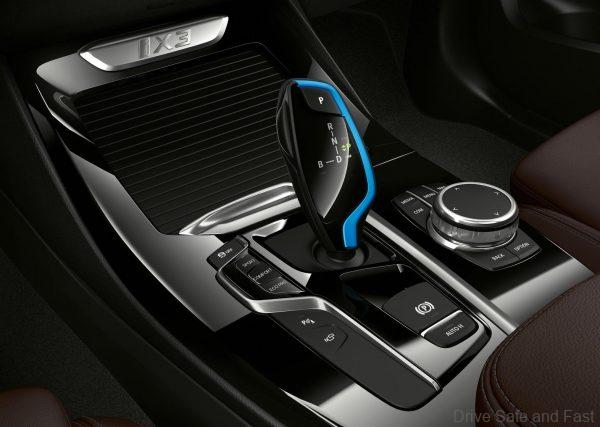
Positive environmental rating over the entire vehicle lifecycle
At the BMW Group, every electrified model has to demonstrate a clearly superior CO2 environmental performance – from procurement of raw materials to the supply chain, production, use phase and recycling – over a comparable conventionally powered vehicle. The BMW iX3 outperforms the diesel-powered BMW X3 xDrive 20d by more than 30 per cent when charging with average European electricity in the use phase and roughly 60 per cent when exclusively green energy is used.
The extensive use of secondary raw materials in the manufacture of aluminium castings and thermoplastics, the absence of rare earths thanks to an innovative design for the electric motor and the across-the-board use of renewable energy in the production of the new BMW iX3, including the cell manufacturing for the high-voltage battery, have also had a positive effect on the car’s environmental footprint. The analysis and conclusions of the environmental assessment for the iX3 – spanning the full value chain and the vehicle’s entire lifecycle – will be verified and certified by an independent testing institute by the time production begins.
The first all-electric Sports Activity Vehicle therefore sets new standards in its class when it comes to efficiency and range, the sparing use of raw materials and the lowering of CO2 emissions throughout the product lifecycle.
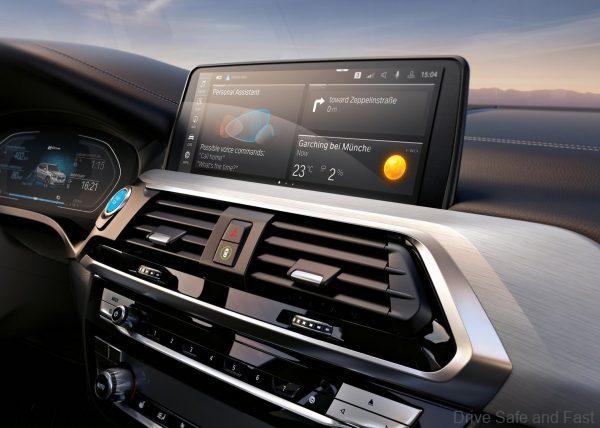
The drive system
The new BMW iX3 blazes a trail for the latest development stage in electrified drive systems. The fifth generation of BMW eDrive technology stands out with its all-new, highly integrated design principle for the drive components. The electric motor, power electronics and transmission are now arranged together in a single housing. The highly integrated electric drive system topology allows a substantial reduction in the installation space required and the weight of the components relative to the power they produce. This has brought about an increase in power density of around 30 per cent compared with the BMW eDrive technology featured in existing electrified models.
The fifth-generation electric drive system will also be fitted in the BMW i4 and BMW iNEXT models from 2021. It is highly scalable and can be adapted to varying vehicle concepts, installation space and power requirements.
The electric motor developed for the new BMW iX3 produces a maximum output of 210 kW/286 hp and develops peak torque of 400 Nm (295 lb-ft) from rest. The new BMW iX3 therefore has by far the most powerful e-drive system ever fitted in an electrified model from the BMW brand. It also helps to generate the driving pleasure for which BMW is renowned, courtesy of its signature performance characteristics and consummate silence. The latest version of the electric motor developed in-house by the BMW Group displays exceptional efficiency of up to 93 per cent.
Another element of the fifth-generation BMW eDrive technology is the high-voltage battery with further developed cell technology. Committed research and development work has allowed the BMW Group to elevate the performance capability and energy density of the battery once again. The gravimetric energy density of the energy storage system has been increased by another 20 per cent over the battery cells used in BMW’s electrically powered models up to now. The high-voltage battery in the new BMW iX3 sets the current benchmark in storage technology for electric energy as far as all the relevant properties – including durability and safety – are concerned. Positioned flat in the vehicle floor of the new BMW iX3, the battery has a gross energy content of 80 kWh. Together with the high efficiency of the electric motor, the new generation of battery cell technology enables an exceptionally high operating range given the size and weight of the high-voltage battery. The new BMW iX3 posts a range of up to460 kilometres (285 miles) in the WLTP test cycle. This equates to a range of up to 520 kilometres (323 miles) when translated back into values for the old NEDC test cycle.
The resultant capability of the new BMW iX3 in everyday use and over long-distance journeys is rooted in an all-encompassing concept for increasing sustainability. It therefore differs significantly from other electric vehicles in its segment, as their range is boosted mostly by ever larger high-voltage batteries – which impacts negatively on the vehicle’s weight and, by extension, its overall efficiency. By contrast, the BMW iX3 stands out with its unique combination of a highly efficient drive system, adaptive recuperation while on the move, low-loss charges at up to 150 kW and extensive measures for reducing air resistance, including innovative aerodynamic wheels. This notably improves both the everyday usability of the all-electric SAV, and above all its long-distance driving ability.
The electric motor: current-excited synchronous motor with sporting performance characteristics and standout efficiency
The BMW Group’s traditional expertise in the development of drive system technology also comes into play with electric mobility. The latest advances in this area give the electric motor making its debut in the new BMW iX3 its specific qualities. A new construction method and a host of innovative detail solutions imbue the motor with mesmerising performance and outstanding efficiency.
The electric motor in the new BMW iX3 works according to the principle of a current-excited synchronous motor and therefore differs significantly from other solutions on the market. The excitation of the rotor is not induced by fixed permanent magnets, but the feed-in of electric power. This design allows the rare earths required for magnetic components to be entirely avoided in the manufacture of the electric motor. Meaning, the BMW Group is not dependent on their availability.
In addition, further progress made in the development of motor technology leads to a significant leap forward in power delivery and efficiency. The drive system can now rev to 17,000 rpm. Maximum output of 210 kW/286 hp is available early on and remains on tap over a wide band up to the rpm red line or the car’s top speed. The motor in the new BMW iX3 generates peak torque of 400 Nm (295 lb-ft) – an extraordinarily high figure for a car of its size – and the driver can access all of this from rest, thanks to judiciously managed excitation of the rotors. Unlike other electric motors, this one also maintains its maximum torque level over a broad rev band. All of which means the driving experience is defined by the car’s ability to not only serve up its power instantaneously but also sustains this power at an extremely constant level, accentuating the car’s sporting character. The new BMW iX3 sprints from 0 to 100 km/h (62 mph) in 6.8 seconds, putting it in the same territory as the conventionally powered BMW X3 xDrive30i. Top speed is electronically limited to 180 km/h (112 mph).
The current-excited synchronous motor design principle also offers unparalleled freedom when it comes to adjusting the amount of excitation, which is induced via electrically generated impulses. Drivers will therefore notice clear differences in the performance profiles of the different driving modes. The highest degree of excitation can be summoned by setting the Driving Experience Control switch to SPORT mode. Here, the motor’s lightning-fast power delivery encourages a sporty driving style with the rapid acceleration it provides. Reduced excitation increases the efficiency of the drive system in COMFORT and ECO PRO modes. Drivers can also choose to have no excitation of the motor at all, in which case the car will also glide along particularly efficiently in coasting mode. There will be no recuperation on the overrun.
The motor’s drive power is transferred along the shortest possible path to the single-ratio transmission, which is installed in the same housing and has likewise been developed and produced by the BMW Group. In the new BMW iX3, the overall electric drive unit – which brings together the electric motor, power electronics and transmission in one place – occupies the space available in the model-specific rear axle subframe. From there, power is sent directly to the rear wheels of the new BMW iX3. This further increases the overall efficiency of the drive system, the reduction in electric power consumption extends the range of the new BMW iX3, and drivers enjoy a classic BMW rear-drive experience. It also offers exceptional performance on snow, ice and loose terrain thanks to standout traction and excellent directional stability. Its advanced driving stability control technology with ARB (near-actuator wheel slip limitation) allows it to sustain relentless forward momentum even in adverse road and weather conditions.

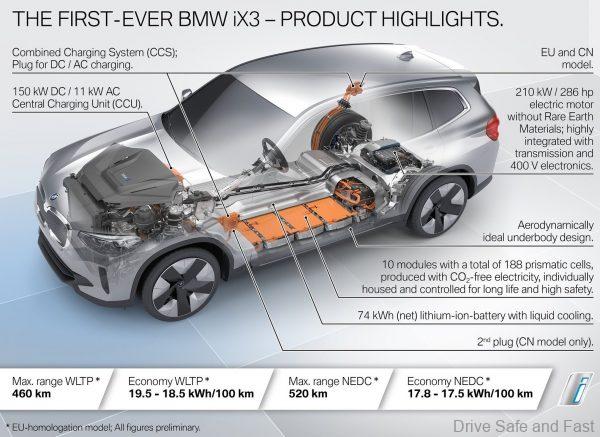
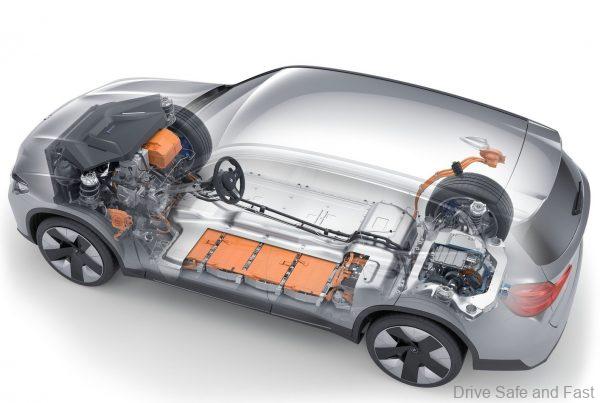
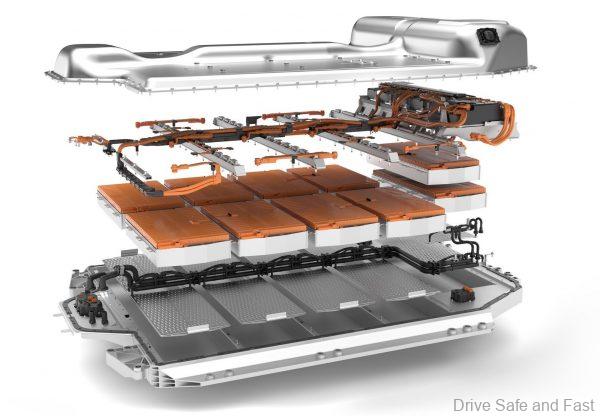
Adaptive recuperation: Intelligent connectivity enhances efficiency and driving comfort
Adaptive recuperation enhances the efficiency of the new BMW iX3 while on the move. This innovative function uses intelligent connectivity to optimise both the car’s range and its driving comfort. The intensity of the Brake Energy Regeneration is adapted to the road situation detected by data from the navigation system and the driver assistance system sensors. For example, when approaching a junction, a speed-restricted stretch of road or a vehicle on the road ahead, recuperation is fully utilized, strengthening the deceleration effect and increases the amount of energy fed back into the high-voltage battery. These adjustments to the driving situation are also carried out when the navigation system’s route guidance function is not activated.
On the open road, the coasting function is activated to enhance efficiency and comfort whenever the driver takes their foot off the accelerator. Also, precise control of the adaptive recuperation enables instantaneous responses to changes in the driving situation. For example, activating the turn signal indicator while coasting immediately initiates recuperation. However, when approaching junctions with traffic lights, Brake Energy Regeneration is cancelled if the lights turn from red to green.
Adaptive recuperation is one of the standard settings activated when the driving position D is engaged using the selector lever on the centre console. Alternatively, the driver can choose a high, medium or low Brake Energy Regeneration setting in the iDrive menu to apply across all driving situations. In driving position D, the new BMW iX3 pulls away at minimal speed as soon as the brake pedal is released, increasing comfort when manoeuvring and in stop-start traffic. Activating driving position B with the selector lever generates the one-pedal feeling characteristic of the BMW Group’s electric vehicles by providing particularly strong recuperation.
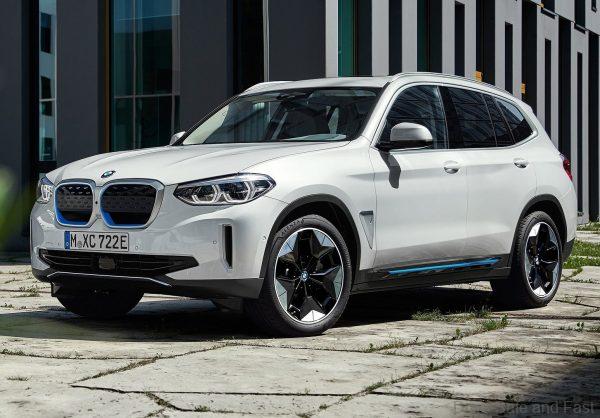
The high-voltage battery: high energy density, controlled use of raw materials
The high-voltage battery in the new BMW iX3 is based on the latest NMC-811 technology with the prismatic design familiar from other BMW applications. Its specific properties are the result of the BMW Group’s rigorous research and development work. The company has been producing modules and batteries for vehicles with electrified drive systems since 2013 and possesses an extraordinarily high level of expertise when it comes to both battery cell technology and the manufacture of model-specific high-voltage batteries. An independently developed modular system with flexible arrangement of the modules allows batteries developed in-house to be integrated into a variety of different vehicle concepts. Underlying work carried out in the fields of cell chemistry and cell design has also put the company in the position to give clear specifications – geared to the particular requirements of use in electrified vehicles – to external battery cell producers.
The high-voltage battery developed for the new BMW iX3 is likewise part of the fifth-generation BMW eDrive technology. Added to which, the latest version of the lithium-ion battery is another example of the BMW Group’s all-encompassing sustainability strategy at work. The amount of raw material cobalt used in the manufacturing of the new high-voltage battery has been reduced by around a third compared with the previous-generation battery. The BMW Group has put in place its own procurement process for the cobalt and lithium it supplies to the producers of the battery cells, part of which involves monitoring compliance with environmental and social standards.
The latest advances in the field of battery technology concern both the performance capacity and energy density of the cells and the structure of the modules and their arrangement in the storage unit. This storage unit has been developed specially for the BMW iX3 and model-specific versions will also feature in electric BMWs to come. For example, the high-voltage battery in the new BMW iX3 has a higher number of cells per module, a reduced component count and a more compact, extremely slim construction.
The high-voltage battery in the new BMW iX3 is composed of 188 individually controllable, prismatic battery cells – each cased in aluminium – which are grouped into 10 modules. The battery is positioned low down in the vehicle floor as an integral component of the body. The new-generation battery weighs 518 kilograms and has a gross energy content of 80 kWh, of which 74 kWh is utilised, giving it an incredibly favourable mass to storage capacity ratio for this class.
A sophisticated cooling and heating system ensures the high-voltage battery is kept at an optimum temperature at all times. Tailored particularly to fifth-generation BMW eDrive technology, its design principle also represents a significant step forward compared to the systems used up to now in the BMW Group’s electrified vehicles. The liquid cooling/heating system serves the storage unit, power electronics and electric motor. A cooling module with two levels and a powerful control unit ensures ideal temperature control for the BMW eDrive components in all operating conditions and virtually any weather. A separate, electrically operated auxiliary heater ensures that the high-voltage battery achieves a consistently high level of effectiveness when starting the car – even in extremely low outside temperatures down to minus 30 degrees Celsius. The interior and battery are heated using a heat pump system. The pump is distinguished by extremely high efficiency; it uses between 40 and 80 per cent less energy than conventional electric heating (depending on the outside temperature), while providing an equally comfortable on-board climate. It extracts excess heat from the motor, drive system control unit and high-voltage battery, as well as the outside air, and feeds it through the air conditioning system. The integrated management system for the climate and heating system also ensures need-based heating of the interior and optimal cooling of the high-voltage battery.
Combined Charging Unit and fast charging at up to 150 kW
The new technological features making their debuts as part of the fifth-generation BMW eDrive technology include an innovative charging unit. The Combined Charging Unit (CCU) used in the new BMW iX3 enables an extremely high degree of flexibility when it comes to plugging the car into charging stations of various types, which means it can feed electric energy into vehicles easily and quickly in countries around the world. When using alternating current (AC) terminals, the CCU enables single-phase charging at up to 7.4 kW and three-phase charging at up to 11 kW. Plugging the vehicle into a direct current (DC) fast-charging station opens the door to much higher charging outputs. And at high-power charging stations – which provide ultra-rapid charging on key transit routes – electrified models from the BMW Group can now benefit from charging outputs of up to 150 kW.
The CCU with an integral 4 kW voltage transformer connected to the 12V on-board power supply – from the lighting, driver assistance systems and audio system to the seat heating – also supplies consumers with electric energy from the car’s high-voltage battery.
The high-voltage battery of the new BMW iX3 can be charged from conventional domestic or industrial sockets, from a Wallbox or at public charging stations. With the car plugged into a Wallbox, the high-voltage battery can be charged from 0 to 100 per cent at up to 11 kW in 7.5 hours. Meanwhile, a direct current (DC) fast-charging station can replenish the battery from 0 to 80 per cent of its full capacity in 34 minutes. A 10-minute charge at one these stations provides enough power to add 100 kilometres (62 miles) to the driving range in the WLTP cycle.
The new BMW iX3 has a combined CCS AC/DC charging socket positioned above the right-hand rear wheel arch.
The design
The exterior design of the new BMW iX3 displays the typical proportions of a Sports Activity Vehicle, which means it provides a visual showcase for the robust premium character and all-round talents espoused by BMW X models. But it also adds a locally emission-free drive system to the mix – without diluting those core SAV attributes in any way. The distinctive identity of the new iX3, encapsulated by its all-electric drive system, is highlighted by model-specific design features. Bespoke modifications for the front/rear apron, the largely enclosed kidney grille and newly developed light-alloy wheels optimise the car’s aerodynamics. Plus, judiciously sited blue accents reference its technological connection with the BMW i brand.
Lines and surfacing guided by the new BMW design language imbue the BMW iX3 with the cutting-edge allure of a Sports Activity Vehicle. Powerful proportions, a long wheelbase, short overhangs and slightly hexagonal wheel arches point to the signature sporting versatility of BMW X models. The sophisticated sense of presence and sporting elegance in the car’s exterior design are emphasised by precise lines and clearly structured surfaces. Moving inside, the raised seating position helps giving the driver a commanding view over the road. Besides that, generous levels of space in all five seats, a premium ambience and a high degree of variability also bring hallmark BMW driving pleasure, a powerful sensation of exclusivity and a high level of everyday practicality to the all-electric variant of the Sports Activity Vehicle.
Optimised aerodynamics create a distinctive presence
The model-specific design of the front end is a case study in functional efficiency. The most eye-catching feature here is the largely enclosed design of the BMW kidney grille and front apron. Chrome surrounds frame the two grille elements, whose inner surfaces have a mesh-like structure of the sort only previously seen in the kidney grilles of elite sporting machines from BMW M. On the BMW iX3, the mesh design is complemented by a familiar BMW i blue accent along the inner edges of the kidney surrounds.
The closed surfaces within the kidney grille reduce air resistance and reflect the lower cooling air requirement of the car’s electric drive system. However, the drive components and brakes of an electrically powered vehicle still require precise temperature control, so the lower air intake and the aperture in the kidney grille (not visible from the outside) both benefit from ten-stage active air flap control. This allows cooling air to flow through to the relevant components in the quantities required.
Innovative aerodynamic wheels increase range
Air Curtains in the outer areas of the front apron guide the air deliberately along the front wheels to minimise turbulence. Teaming the Air Curtains with innovative, aerodynamically optimised light-alloy wheels proves highly effective in smoothing those air flows around the wheel arches that most influence the vehicle’s overall drag. The aerodynamic wheels fitted to the new BMW iX3 reduce its drag coefficient by around 5 per cent compared to an equivalent vehicle with conventional light-alloy wheels. The consequent improvement in efficiency adds around 10 kilometres (6 miles) to the range of the new BMW iX3 in the WLTP test cycle.
The innovative new aerodynamic wheels blend their reduced air resistance with the sporting elegance of a V-spoke aluminium wheel. The dimensions of the base wheel ensure it meets all the structural challenges involved in transmitting dynamic driving forces to the road. Meanwhile, inserts with a high-class finish are responsible for achieving the necessary aerodynamic impact. This new design principle opens up additional scope for customising the wheels. Furthermore, they weigh around 15 per cent less than the previous BMW light-alloy items with aerodynamically optimised surfaces. The BMW iX3 is fitted with 19-inch aerodynamic wheels as standard and can also be ordered with optional 20-inch items.
The underbody of the new BMW iX3 is largely enclosed – with the help of precisely sculpted panelling and air deflectors – due to the positioning here of the high-voltage battery housing. Measures including airflow-optimised stiffening ribs, carefully channelled airflow around the front wheels and a rear axle cover enhance aerodynamics. A special cover for the rear struts optimises airflow to the rear diffuser. The all-electric – and therefore exhaust-system-free – drive concept enables a smooth and sealed surface design for the underbody and rear apron, which also has a positive effect on aerodynamics. Blue inlays in the rear diffuser draw attention to the vehicle’s highly sustainable character. Together, these optimisation measures give the new BMW iX3 a drag coefficient (Cd) of 0.29. The Air Breathers in the front side panels come in Pearl-effect Chrome and carry the BMW i logo. Blue inlays for the side skirts and the use of the signature BMW i colour for the outline of the brand logo on the bonnet, tailgate and wheel rims set the seal on the distinctive visual identity of the new BMW iX3.
Opinion and Text by Joshua Chin


